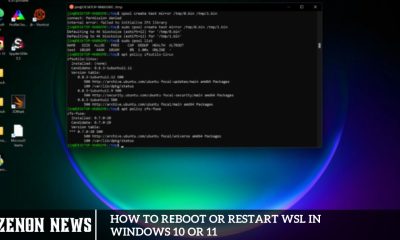News
Effective Marketing Strategies for Competitive Industries

Digital marketing has become indispensable for any company to distinguish itself and attract customers. Standing out and drawing in clientele is especially crucial in industries with numerous competitors. To achieve this, businesses must employ effective digital strategies that differentiate them from others and deliver tangible results. This article will explore successful tactics and methods for digital advertising in highly competitive sectors, focusing on engagement and exposure. Additionally, we will demonstrate how to leverage Best in Hood platforms to enhance your business’s digital presence.
Marketing is a communication process to boost sales volume, enhance brand awareness, and foster customer loyalty. It encompasses various strategies tailored to achieve these objectives. One such strategy is competitive marketing, where businesses vie to outperform their competitors by providing superior deals and discounts. This endeavor is often executed through avenues like advertisements and social media campaigns.
What is a Marketing Strategy?
In its simplest form, a marketing strategy outlines a plan of action to achieve a specific goal. It serves as a roadmap to attain objectives or targets, whether brand building, customer acquisition, or retention. Companies employ marketing strategies to enhance sales and revenues, thereby maximizing profits.
Various marketing techniques contribute to business growth, with some proving exceptionally effective in achieving customer acquisition, retention, and product development goals. Here, we’ve compiled the top 15 competitive marketing strategies that aspiring online entrepreneurs should implement to succeed in their ventures:
Precision Advertising Campaigns
In a competitive industry, your advertising campaigns must focus on audience segments with the highest conversion rates. Utilize Google Ads, Facebook Ads, and LinkedIn Ads to create highly targeted campaigns based on demographics, interests, and online behavior. Investing more in advertising to reach the right audience will enhance the ROI of your marketing efforts.
Search Engine Optimization
SEO is crucial in ensuring your website appears prominently in search engine results pages (SERPs), especially in highly competitive industries. Conduct thorough keyword analysis to identify your target audience’s most relevant search phrases. Optimize your website’s content, metatags, and images based on these keywords. Additionally, build quality backlinks from authoritative websites to enhance your domain authority in the eyes of search engines.
Influencer Partnerships
Partnering with industry influencers expands your brand’s reach and amplifies your message to a broader audience. Identify influencers who resonate with your company values, target demographics, and potential partnership opportunities, such as sponsored articles, brand ambassadorships, and product reviews. Influencer marketing proves highly effective in competitive industries, particularly those where trustworthiness and credibility significantly influence purchasing decisions.
Assessments of Online Services and Reputation Oversight
Trust and credibility are pivotal factors consumers weigh heavily when purchasing in competitive industries. Encourage satisfied clients to share positive feedback on platforms like Google My Business or Yelp and industry-specific review websites. Responsively address negative and positive reviews professionally, showcasing your dedication to customer service and bolstering trust among potential clients.
Local Search Engine Optimization (SEO) and Web-Based Directories
Local businesses operating in industries with significant competition and a sizable local market must prioritize optimizing their presence on online directories. Claiming and optimizing your business listings across platforms such as Google My Business, Bing Places, Yelp, and industry-specific directories is crucial. Maintain consistency in your business name and address across all online directories to enhance visibility and credibility.
Ideal Client Profile (ICP) – Defining Your Target Audience
Conducting comprehensive market research, both internally and externally, lays the groundwork for a robust strategy. A proficient marketer understands the company’s ideal client, recognizing that the perfect client can vary across departments. What might be a suitable client for integration and accounting could pose challenges for operations.
Balancing the requirements of all departments is crucial in shaping your competitive strategy.
Once your target audience is defined, it’s essential to delineate specific market segments. This step further refines your target audience, encompassing demographic, geographic, psychographic, or behavioral traits.
Equipped with data on the target audience and market segmentation, you can construct a fictional Buyer Persona. This persona represents your ideal customer, incorporating details such as pain points, purchasing habits, age, and income.
With a meticulously researched target audience, you’re poised to embark on the next phase of your company’s competitive strategy.
Cost Leadership Strategy
The cost leadership strategy, often called the “low-cost strategy,” resonates well with cost-conscious consumers. It’s particularly advantageous for brands with a lean cost structure, enabling them to boost revenue through increased volume.
Companies like Walmart, Spirit Airlines, and Dollar General have successfully executed numerous benefits associated with this competitive approach. By focusing on high volume, businesses can negotiate lower material costs and invest in automation to mitigate overhead labor expenses.
This strategy is particularly suited for larger organizations capable of managing narrow profit margins and willing to lower prices to maintain market dominance.
Provide Excellent Customer Service
Outstanding customer service plays a pivotal role in customer retention and acquisition. Businesses prioritizing excellent customer service are more likely to retain existing customers and attract new ones through positive word-of-mouth referrals. Investing in customer service training for your team and implementing efficient systems to promptly address and resolve customer issues are essential steps. Delivering exceptional customer service fosters trust and loyalty and enhances your business’s reputation.
Forge connections and partnerships with other businesses and industry professionals.
Networking and collaboration can be highly beneficial for fostering relationships and growing your business. Explore opportunities to join industry organizations or participate in events like trade shows and conferences, where you can connect with fellow business owners and professionals. Additionally, proactively contact other businesses to explore collaboration possibilities, including resource sharing, cross-promotion of products or services, or joint project partnerships. You can gain valuable insights, establish meaningful connections, and expand your business’s reach through networking and collaboration efforts.
Crafting Your Marketing Strategy
Setting Clear Objectives:
Clearly define your goals and objectives, ensuring they are specific, measurable, achievable, relevant, and time-bound (SMART). This will provide a roadmap for your marketing efforts and allow you to gauge success accurately.
Target Audience Segmentation:
Identify and segment your target audience based on demographics, psychographics, behavior, and other relevant factors. Tailor your marketing messages and tactics to resonate with each segment, maximizing engagement and conversion opportunities.
Unique Selling Proposition (USP):
Develop a compelling USP that succinctly communicates what sets your product or service apart from competitors. Highlighting your unique benefits helps differentiate your brand in consumers’ minds and fosters brand loyalty.
Brand Positioning:
Establish a clear and distinctive brand identity that reflects your values, personality, and positioning in the market. Consistently communicate your brand message across all marketing channels to build brand recognition and trust among your target audience.
Digital Marketing Tactics for Competitive Edge
Search Engine Optimization (SEO):
Implement SEO strategies to enhance your online visibility and improve your website’s rankings on search engine results pages (SERPs). By optimizing your website’s content, meta tags, and backlink profile, you can attract organic traffic and outperform competitors in search engine rankings.
Content Marketing:
Create valuable and relevant content that addresses the needs and interests of your target audience. By producing high-quality blog posts, articles, videos, and other content formats, you can establish thought leadership, drive traffic to your website, and engage potential customers throughout their buying journey.
Pay-Per-Click (PPC) Advertising: Leverage PPC advertising platforms like Google Ads and social media advertising to target specific audience segments with highly relevant ads. By bidding on relevant keywords and demographics, you can drive targeted traffic to your website, generate leads, and increase conversions effectively.
Social Media Marketing:
Engage with your audience on social media platforms like Facebook, Instagram, Twitter, and LinkedIn. You can build brand awareness, cultivate brand loyalty, and drive website traffic by sharing compelling content, running targeted ad campaigns, and fostering meaningful interactions.
Email Marketing:
Develop personalized email campaigns to nurture leads, retain customers, and drive conversions. By segmenting your email list, crafting compelling email content, and optimizing your email send times, you can deliver relevant messages that resonate with your audience and encourage action.
Analyzing and Iterating
Performance Metrics:
Monitor key performance indicators (KPIs) to evaluate the effectiveness of your marketing efforts. Track metrics such as website traffic, conversion rates, click-through rates, and customer acquisition costs to gain insights into the performance of your campaigns and initiatives.
A/B Testing:
Conduct A/B tests to compare different variations of your marketing assets, such as ad creatives, landing pages, email subject lines, and call-to-action buttons. By testing and analyzing the performance of each variation, you can identify which elements resonate best with your audience and optimize your marketing efforts accordingly.
Feedback and Adaptation:
Seek feedback from customers, stakeholders, and internal teams to gain valuable insights into the effectiveness of your marketing strategies. Use customer surveys, focus groups, and social listening tools to gather feedback and identify areas for improvement. Continuously adapt and refine your marketing approach based on feedback and emerging trends to stay agile and competitive in your industry.
Frequently Asked Questions
What are some effective marketing strategies for competitive industries?
In competitive industries, it’s crucial to differentiate your brand. Consider strategies such as niche marketing, where you focus on a specific segment of the market, or personalized marketing to tailor your message to individual customers.
How can I leverage social media in a competitive market?
Social media can be a powerful tool in competitive industries. Focus on creating engaging content, building a solid brand presence, and interacting with your audience regularly. Utilize targeted advertising and influencer partnerships to reach potential customers effectively.
What role does customer experience play in marketing within competitive industries?
Customer experience can be a significant differentiator in competitive markets. Providing exceptional service, personalized interactions, and seamless transactions can help you stand out from competitors and build customer loyalty.
How important is innovation in marketing for staying ahead in competitive industries?
Innovation is essential for staying ahead in competitive industries. Experiment with new marketing techniques, technologies, and strategies to continually evolve and meet changing customer needs. Embrace creativity and be willing to take calculated risks to stay ahead of the competition.
How can I effectively measure the success of my marketing efforts in a competitive market?
Utilize key performance indicators (KPIs) such as customer acquisition cost, customer lifetime value, and return on investment (ROI) to measure the success of your marketing efforts. Conduct regular analysis and gather customer feedback to continuously refine your strategies and stay competitive.
What are some cost-effective marketing strategies for businesses operating in competitive industries?
Content marketing, email marketing, and search engine optimization (SEO) are all cost-effective strategies that can yield significant results in competitive industries. Focus on creating high-quality, valuable content that resonates with your target audience and attracts organic traffic to your website.
How can I differentiate my brand from competitors in a crowded market?
Differentiate your brand by highlighting your unique selling propositions (USPs) and showcasing what distinguishes you from competitors. This could include superior quality, innovative features, exceptional customer service, or a compelling brand story. Consistently communicate these differentiators across all marketing channels to reinforce your brand identity.
Conclusion
Through this exploration of effective marketing strategies, it’s evident that differentiation, innovation, and customer-centric approaches are crucial to success.
Businesses can carve out their unique place in the market by leveraging niche marketing, personalized experiences, and social media engagement. Moreover, a relentless focus on customer experience and continuous innovation ensures relevance and resilience in the face of competition.
Businesses must measure their marketing efforts, stay agile, and remain attuned to market dynamics. Strategic market research and a commitment to refining strategies based on feedback and data analysis can help companies continuously refine their approach and maintain a competitive edge.
News
White Hair and Natural Prevention Methods – Wellhealthorganic.com

Have you started noticing white strands among your once-pigmented hair? You might be wondering what’s causing this change and how to prevent it. Don’t worry; you’re in the right place! Welcome to WellHealthOrganic’s guide on understanding the causes of white hair and exploring natural prevention methods.
Imagine this scenario: you’re preparing for a special event, and a silver strand catches your eye as you glance in the mirror. While some embrace the wisdom that comes with gray hair, others may wish to preserve their youthful appearance a little longer. Regardless of your perspective, we’re here to explore the science behind this change and provide natural, practical strategies to maintain your hair’s vitality.
So, find a comfortable spot, brew a soothing cup of herbal tea, and join us on a journey to uncover the secrets of white hair and discover ways to nurture your locks with care. Your hair deserves the best, and we’re here to guide you every step of the way.
White Hair: WellHealthOrganic.com’s Guide to Causes and Natural Prevention
Imagine having a trusted resource that serves as your guide to navigating the complexities of white hair. That’s precisely what “WellHealthOrganic.com’s Guide to White Hair Causes and Natural Prevention” offers!
This website is your go-to source for understanding why your hair might be turning white and discovering easy, natural methods to prevent it. Think of it as a knowledgeable friend who shares insights on why hair changes color and how to maintain its natural hue without relying on harsh treatments.
Covering everything from the science behind white hair to practical tips for preserving your hair’s youthful appearance, this resource has it all. If you’re curious about those emerging white strands and eager to explore natural remedies, WellHealthOrganic.com is your guide.
The Importance of WellHealthOrganic.com’s Guide to White Hair Causes and Natural Prevention
Understanding why hair turns white and discovering natural prevention methods is essential for maintaining vibrant, healthy locks. Here’s why this knowledge matters:
Preserve Your Youthful Appearance:
By understanding the causes of white hair, you can take proactive measures to extend your youthful appearance. Natural prevention techniques help retain your hair’s original color, keeping you looking and feeling youthful for longer.
Empowerment Through Knowledge:
Knowledge empowers you to make informed decisions about hair care. WellHealthOrganic.com provides the information you need to manage your hair’s health confidently.
Avoid Harmful Chemicals:
Many commercial hair products contain harsh chemicals that can damage your hair. Natural prevention methods help you avoid these substances, protecting your hair and scalp.
Holistic Well-Being:
Hair care is not just about aesthetics; it’s about overall well-being. Natural methods support your health by promoting a balanced lifestyle and enhancing your overall wellness.
Boost Self-Confidence:
Maintaining your natural hair color can significantly enhance your self-esteem. Preventing premature graying through natural methods can boost your confidence and positively impact your self-image.
Sustainable Hair Care:
Natural remedies are often more eco-friendly than conventional products. By choosing natural methods, you reduce your environmental footprint and support sustainable practices.
Long-Term Hair Health:
Natural prevention focuses on nurturing your hair from within. A holistic approach promotes long-term health and vibrancy, ensuring strong and healthy hair for years.
Comprehensive Step-by-Step Guide to Natural Hair Care | WellHealthOrganic.com
Understanding White Hair Causes:
Discover the factors contributing to white hair, such as genetics, aging, and environmental influences. Understand the role of melanin, the pigment responsible for hair color, and how its gradual decline leads to the appearance of white hair.
Assessing Genetic Factors:
Explore how family history and genetics influence the onset and extent of white hair. Consider genetic insights or consult healthcare professionals to assess your risk factors.
Exploring Environmental Influences:
Identify how pollutants, UV rays, and chemical treatments can accelerate graying. Take proactive steps to minimize exposure to these harmful elements and protect your hair from damage.

Embracing Natural Prevention Methods:
Explore natural methods to prevent white hair without relying on harsh chemicals. Embrace a holistic approach with proper nutrition, stress management, and natural hair care routines.
Nourishing Your Body:
Understand how a balanced diet supports healthy hair and can help delay graying. Incorporate antioxidant-rich foods and essential nutrients to maintain hair pigmentation and overall vitality.
Managing Stress:
Recognize how stress affects hair health and contributes to premature graying. Practice relaxation techniques like meditation, yoga, and deep breathing to manage stress and support healthy hair.
Adopting Natural Hair Care Routines:
Implement gentle hair care practices, including regular washing and conditioning. Use natural products free from harsh chemicals to preserve your hair’s color and health.
Incorporating Herbal Remedies:
Explore herbal treatments like henna, amla, and sage to enhance your hair color. Experiment with homemade masks and natural remedies to strengthen and nourish your hair.
Seeking Professional Advice:
Consult a healthcare provider if you experience sudden changes in hair color. Discuss treatment options and receive personalized care tailored to your specific needs.
Extra Tips for Naturally Preventing White Hair
Stay Hydrated: Drink plenty of water to keep your hair and scalp hydrated, preventing dryness that can lead to graying.
Protect from Sun Exposure: Use hats or UV protection to shield your hair from the sun’s harmful rays.
Limit Heat Styling: Reduce heat styling tools to avoid damaging your hair.
Massage Your Scalp: Stimulate blood flow with regular scalp massages to promote healthy hair growth.
Trim Regularly: Regular trims help prevent split ends and keep your hair looking its best.
Use Gentle Accessories: Opt for accessories made from soft materials to avoid hair breakage.
Practice Patience: Natural remedies take time to show results, so be consistent and patient.
Embrace Gray Gracefully: If white hair appears, wear it confidently as a mark of experience and wisdom.
Stay Positive: Focus on maintaining healthy hair and embracing positive changes.

Advantages and Disadvantages of Natural Hair Care
Advantages:
Healthier Hair: Natural methods provide essential nutrients to nourish your hair and scalp.
Sustainable Approach: Eco-friendly practices reduce your environmental impact.
Cost-Effective: Natural remedies are often more affordable than commercial treatments.
Reduced Chemical Exposure: Avoid harsh chemicals to protect your hair’s health.
Holistic Wellness: Support overall health with a balanced lifestyle.
Customizable Solutions: Tailor natural methods to meet your individual needs.
Long-Term Benefits: Maintain your hair’s natural color and vitality over time.
Disadvantages:
Time-Consuming: Requires consistency and patience to see results.
Limited Efficacy: Results can vary based on individual factors.
Lack of Immediate Results: Natural remedies may take longer to show effects.
Need for Consistency: Requires dedication to maintain a routine.
Professional Consultation: Severe cases might need medical advice.
Cultural or Social Pressure: Societal expectations may influence decisions.
Potential Inconvenience: Additional steps and preparation compared to commercial products.
Frequently Asked Questions
What causes white hair?
A: White hair can be caused by various factors, including genetics, aging, stress, and environmental influences. The gradual decrease in melanin, the pigment responsible for hair color, is a primary factor.
Can natural methods prevent white hair?
A: Natural methods can help slow the graying process by nourishing the hair and scalp, but results may vary depending on individual factors such as genetics and overall health.
What are some effective natural remedies for preventing white hair?
A: Effective natural remedies include a balanced diet rich in antioxidants, regular scalp massages, herbal treatments like henna and amla, and a healthy lifestyle to manage stress.
How does diet impact the prevention of white hair?
A: A balanced diet supports hair health by providing essential nutrients for hair pigmentation. Foods rich in antioxidants and vitamins, such as fruits, vegetables, nuts, and seeds, are particularly beneficial.
Are there any specific herbs that can help maintain hair color?
A: Yes, herbs such as henna, amla, sage, and rosemary are known for their properties in enhancing hair color and promoting overall hair health.
How can I protect my hair from environmental damage?
A: Protect your hair from pollutants, UV rays, and harsh chemicals by wearing hats, using UV protection products, and using natural, gentle hair care products. Avoid excessive heat styling and chemical treatments.
What role does stress play in graying hair?
A: Stress can accelerate the graying process by affecting melanin production. Managing stress through relaxation techniques such as meditation, yoga, and deep breathing can help maintain hair color.
Conclusion
White hair is a natural part of aging that can be influenced by genetics, lifestyle, and environmental factors. While the appearance of white strands is often inevitable, understanding the underlying causes and exploring natural prevention methods can help maintain your hair’s health and color for as long as possible.
Adopting a holistic approach, including a balanced diet rich in essential nutrients, regular scalp massages, and herbal treatments like henna and amla, can support hair vitality. Protecting your hair from environmental damage and managing stress through relaxation techniques are crucial steps in this journey.
At WellHealthOrganic.com, we believe in the power of natural remedies and sustainable practices. Choosing gentle, eco-friendly hair care routines protects your hair from harsh chemicals and contributes to a healthier planet.
News
Key Signs of Gastroenteritis – Essential Guide from WellHealthOrganic.com

Gastroenteritis, often called stomach flu, is a common condition characterized by inflammation of the stomach and intestines. It is typically caused by infectious agents such as viruses, bacteria, or parasites, leading to significant discomfort and potential health risks.
Recognizing the critical signs of gastroenteritis, as detailed on WellHealthOrganic.com, is crucial for prompt and effective treatment. This comprehensive guide delves into the primary indicators of gastroenteritis and offers practical advice for managing and preventing the condition.
What is Gastroenteritis?
Gastroenteritis is an inflammation of the stomach lining and intestines, leading to symptoms such as diarrhea, vomiting, and abdominal cramps. It can be caused by infections from viruses (such as norovirus or rotavirus), bacteria (like Salmonella or E. coli), or parasites. Poor hygiene, contaminated food or water, and close contact with infected individuals are common ways the disease spreads.
Signs of Gastroenteritis: Insights from WellHealthOrganic.com
WellHealthOrganic.com: Key Signs of Gastroenteritis is a valuable resource designed to educate readers about the essential aspects of gastroenteritis. The article thoroughly overviews this common condition’s symptoms, causes, and treatment options. It aims to help individuals recognize and manage gastroenteritis effectively, providing insights for early detection and proper care to reduce discomfort and mitigate health risks.
Could you share how you discovered this article? Are you exploring gastroenteritis for personal knowledge or professional purposes?
Why Understanding the Key Signs of Gastroenteritis on WellHealthOrganic.com Matters
Early Detection
Identifying gastroenteritis symptoms early is crucial for prompt treatment. Early detection can help relieve symptoms more quickly, decrease the risk of dehydration, and prevent the spread of infection to others.
Prevention of Transmission
Gastroenteritis can spread quickly, mainly when caused by highly contagious viruses like norovirus and rotavirus. Knowing the signs allows individuals to implement preventive measures, helping to reduce transmission in places such as schools, workplaces, and healthcare settings.
Effective Management
Effective management of gastroenteritis involves more than alleviating symptoms. It includes ensuring proper hydration, following dietary recommendations, and recognizing when to seek medical attention. Adequate management can prevent complications and speed up recovery.
Preventing Complications
If left untreated, gastroenteritis can result in severe dehydration and other complications, especially in vulnerable groups like infants, the elderly, and those with weakened immune systems. Recognizing symptoms and responding appropriately are crucial for preventing severe health problems.
Knowing When to Seek Medical Help
Understanding the severity of symptoms helps guide informed decisions about seeking medical care. While many cases of gastroenteritis resolve on their own, severe or prolonged symptoms may necessitate medical intervention. Being well-informed empowers individuals to seek timely medical attention when necessary.

Step-by-Step Guide to Identifying Key Signs of Gastroenteritis on WellHealthOrganic.com
Recognizing Early Symptoms
Gastroenteritis commonly starts with nausea and vomiting due to stomach irritation. Persistent vomiting can result in dehydration. To manage these symptoms:
- Sip clear fluids, such as water or oral rehydration solutions, to stay hydrated.
- Avoid solid foods until the vomiting has ceased.
- Gradually reintroduce bland foods, like crackers or toast, once vomiting subsides.
Identifying Diarrhea
Diarrhea, marked by frequent loose stools, is a key symptom of gastroenteritis. To prevent dehydration and electrolyte imbalance:
- Drink plenty of fluids to replenish lost electrolytes.
- Avoid dairy, fatty, or spicy foods that can worsen diarrhea.
- Consume small, frequent meals of easily digestible foods.
Managing Abdominal Discomfort
Abdominal pain and cramps, often caused by intestinal inflammation, can be managed by:
- Apply a warm compress to the stomach to ease discomfort.
- Using over-the-counter pain relief, if recommended by a healthcare professional.
- Avoiding trigger foods that may exacerbate the pain.
Addressing Fever
A low-grade fever may occur with gastroenteritis. Manage it by:
- Taking fever-reducing medications as directed.
- Staying hydrated helps regulate body temperature.
- Resting in a comfortable and relaxed environment.
Preventing Dehydration
Dehydration is a significant concern, especially for vulnerable groups. To prevent it:
- Drink oral rehydration solutions or fluids rich in electrolytes.
- Monitor urine output and seek medical help if dehydration symptoms persist.
Seeking Medical Advice
Seek medical attention if symptoms are severe or persistent, if there is blood in vomit or stool, or if the condition affects vulnerable individuals.
Preventive Measures
Prevent gastroenteritis by practicing good hygiene and safe food handling:
- Wash hands thoroughly and handle food safely.
- Cook food thoroughly and avoid consuming undercooked meats.
- Drink clean water from safe sources.
Recovery Essentials
Recover with rest, hydration, and gradual food reintroduction:
- Rest and hydrate regularly.
- Start with bland foods like BRAT diet items (bananas, rice, applesauce, toast).
- Monitor recovery progress and adjust activity levels accordingly.
Managing Symptoms
Manage symptoms of gastroenteritis by:
- Staying hydrated.
- Eating small, easily digestible meals.
- Getting plenty of rest.
- Maintaining good hygiene.
- Monitoring the severity of symptoms.
Infectious Gastroenteritis
Viruses, bacteria, or parasites cause infectious gastroenteritis. Each type of infection occurs when the pathogen is ingested, typically through contaminated food or drink. Here are some common types of infectious gastroenteritis:
Escherichia coli Infection: Often encountered by travelers in areas with poor sanitation, this infection is caused by drinking contaminated water or eating tainted raw fruits and vegetables.
Campylobacter Infection: Found in animal feces and undercooked meat, particularly poultry, this bacterial infection results from consuming contaminated food or water, eating undercooked meat (especially chicken), or failing to wash hands after handling infected animals.
Cryptosporidium Infection: This parasitic infection, which can be contracted from swimming in contaminated pools or through contact with infected animals, spreads when parasites are transferred to food or surfaces by an infected person who hasn’t washed their hands after using the toilet.
Giardiasis: Caused by a parasitic infection of the bowel, giardiasis can be contracted by drinking contaminated water, handling infected animals, or changing the diaper of an infected baby without proper handwashing.
Salmonellosis: This bacterial infection in animal feces is spread by eating contaminated food or handling infected animals. Infected individuals can also spread bacteria to others or surfaces by not washing their hands thoroughly.
Shigellosis: Caused by bacteria in human feces, shigellosis can be transmitted when an infected person contaminates food or surfaces by not washing their hands after using the toilet.
Viral Gastroenteritis: This infection is spread through person-to-person contact, such as touching contaminated hands, feces, or vomit or by consuming contaminated food or water.
Treatment and Management of Gastroenteritis
Managing gastroenteritis involves addressing symptoms and preventing complications. Here’s how you can manage the condition:
Hydration
Drinking plenty of fluids is essential to replace lost fluids and prevent dehydration. Oral rehydration solutions (ORS) are recommended for rehydration.
Rest
Adequate rest helps the body recover from the infection and reduces symptoms.
Diet
Once vomiting subsides, start with bland, easily digestible foods such as toast, rice, and bananas. Avoid spicy, fatty, or dairy-rich foods initially.
Medications
Over-the-counter medications like anti-diarrheal drugs may be used, but it’s essential to consult a healthcare provider before use. Antiemetics may be prescribed for severe vomiting.
Preventing Spread
Practice good hygiene by washing hands thoroughly, especially after using the bathroom and before eating. Disinfect contaminated surfaces and avoid close contact with infected individuals.
Stomach Flu and Children
Children and infants are particularly vulnerable to rapid dehydration. If dehydration occurs, it’s crucial to seek medical attention immediately. Signs of dehydration in young children include:
- Sunken soft spot on the baby’s head
- Sunken eyes
- Dry mouth
- Absence of tears when crying
- Reduced urination or very little urine
- Low alertness and energy (lethargy)
- Increased irritability
Gastroenteritis, mainly when caused by a viral infection, is contagious. Children are more prone to experiencing severe symptoms, so it is essential to keep them home from daycare or school until all symptoms have resolved.
Two oral vaccines, RotaTeq and Rotarix, are available to protect against rotavirus, one of the most common causes of viral gastroenteritis. These vaccines are recommended for children starting at two months of age. Consult your doctor to determine if your child should receive these vaccines.
Before administering any medication to your child, consult with a healthcare provider. Over-the-counter drugs to control vomiting are generally not recommended for children under five years old, and medicines for diarrhea are typically not advised for those under 12 years old (some doctors may recommend avoiding these for individuals under 18).

Pros and Cons of Recognizing Gastroenteritis Symptoms
Advantages:
Early Detection and Treatment: Recognizing symptoms early allows for prompt medical intervention, potentially shortening the duration of the illness and reducing its severity.
Prevention of Complications: Awareness of symptoms enables individuals to take preventive measures, such as staying hydrated and resting, which can help prevent complications like dehydration and electrolyte imbalances.
Effective Management: Understanding symptoms facilitates better self-care, including appropriate dietary adjustments and medication use under medical guidance, to manage symptoms effectively.
Reduced Transmission: Identifying symptoms helps individuals take precautions to prevent spreading the infection, reducing transmission in settings such as schools, workplaces, and healthcare environments.
Empowerment and Preparedness: Knowledge of symptoms empowers individuals to make informed decisions about seeking medical care and managing their health, fostering a sense of preparedness and control over their condition.
Disadvantages:
Self-Diagnosis Risks: Misinterpreting symptoms or relying solely on self-diagnosis without professional confirmation can result in incorrect treatment or delayed medical attention.
Anxiety and Stress: Excessive focus on symptoms or constant monitoring may lead to unnecessary anxiety or stress, especially if symptoms are mild or transient.
Misinformation: Relying on unreliable sources or incomplete information about symptoms can cause misunderstandings and incorrect management approaches.
Varied Presentation: Gastroenteritis symptoms can vary greatly in presentation and severity, making it difficult for individuals to assess their condition without medical expertise.
Compliance Issues: Understanding symptoms does not always ensure proper adherence to treatment or preventive measures, mainly if individuals underestimate the seriousness of their condition or fail to follow medical advice.
Frequently Asked Questions
What are the common symptoms of gastroenteritis?
Common symptoms include nausea, vomiting, diarrhea, abdominal pain or cramps, and sometimes fever. These symptoms result from inflammation of the stomach and intestines.
How can I differentiate gastroenteritis from other stomach illnesses?
A combination of nausea, vomiting, diarrhea, and abdominal cramps typically characterizes Gastroenteritis. Unlike other conditions, it often follows exposure to contaminated food or water. If symptoms are severe or persistent, consult a healthcare professional for a proper diagnosis.
What causes gastroenteritis?
Gastroenteritis is usually caused by infectious agents such as viruses (e.g., norovirus, rotavirus), bacteria (e.g., Salmonella, E. coli), or parasites. It can also result from consuming contaminated food or water.
How is gastroenteritis treated?
Treatment focuses on managing symptoms and preventing dehydration. This includes drinking plenty of fluids, using oral rehydration solutions, resting, and gradually reintroducing bland foods. Over-the-counter medications may help alleviate symptoms, but severe cases may require medical attention.
When should I seek medical attention for gastroenteritis?
Seek medical attention if symptoms are severe or persistent, include blood in vomit or stool, or if you are part of a vulnerable group such as infants, the elderly, or those with weakened immune systems.
How can I prevent gastroenteritis?
Prevent gastroenteritis by practicing good hygiene, such as washing hands thoroughly, handling food safely, cooking food properly, and drinking clean water. Avoid consuming food from unreliable sources.
Can gastroenteritis be contagious?
Yes, gastroenteritis can be highly contagious, mainly when caused by viruses like norovirus and rotavirus. Practicing good hygiene and taking precautions can help prevent the spread of infection.
What are the potential complications of gastroenteritis?
Complications of gastroenteritis may include severe dehydration, electrolyte imbalances, and, in rare cases, more serious infections. It is essential to stay hydrated and seek medical help if symptoms worsen.
How can I manage gastroenteritis symptoms at home?
Manage symptoms by staying hydrated with clear fluids or oral rehydration solutions, resting, avoiding solid foods until vomiting subsides, and gradually reintroducing bland foods. Monitor your symptoms and consult a healthcare provider if needed.
What should I do if symptoms do not improve?
If symptoms do not improve or worsen over time, or if you experience severe symptoms like prolonged vomiting, diarrhea, or signs of dehydration, seek medical advice for further evaluation and treatment.
Conclusion
critical signs of gastroenteritis are crucial for effectively managing and preventing this common condition. By recognizing symptoms such as nausea, vomiting, diarrhea, and abdominal pain early, individuals can seek timely medical intervention, prevent complications, and reduce the risk of transmission to others. This essential guide from WellHealthOrganic.com provides valuable insights into identifying symptoms, managing them appropriately, and taking preventive measures. Staying informed and proactive empowers individuals to handle gastroenteritis more effectively, ensuring a quicker recovery and minimizing the impact on their overall health. Always consult a healthcare professional to ensure proper care and treatment for persistent or severe symptoms.
News
Nasik Fatafat Result Information – Complete Guide

Nasik residents, are you ready to explore “Nasik Fatafat“? Imagine this: you’re balancing work, family, and daily tasks when you suddenly remember you need groceries or have an urgent document to send.
No need to worry—Nasik Fatafat is here to help! This guide delves into what Nasik Fatafat is, why it’s a game-changer, and how it can instantly simplify your life.
Join us on a Fatafat journey and uncover the convenience it brings to vibrant Nasik!
Visit Now: Kolkata Fatafat
What is Nasik Fatafat

Nasik Fatafat is like your magical genie in a bottle, but instead of granting wishes, it helps you get things done quickly and effortlessly. This super handy service is right at your fingertips, designed to make your life easier and more convenient.
Whether you need groceries in a hurry, a delicious meal delivered to your doorstep, or important documents couriered across town, Nasik Fatafat is the go-to solution. Think of it as your personal assistant, always ready to tackle your errands swiftly and efficiently.
So, the next time you’re in a pinch or just looking to save time, remember to summon Nasik Fatafat for all your needs!
Why is Nasik Fatafat Important?
Nasik Fatafat isn’t just another service; it’s a game-changer in handling our daily tasks and responsibilities. Here’s why it’s so crucial:
Time-Saving Convenience:
In today’s fast-paced world, time is of the essence. Nasik Fatafat saves you precious time by eliminating the need to physically visit stores or run errands.
With just a few taps on your phone, you can have your groceries delivered, meals ordered, or bills paid without leaving your home or office. Nasik Fatafat is designed to make your life more convenient, giving you more time to focus on what truly matters.
Stress Reduction:
Say goodbye to the stress and hassle of rushing through crowded streets or waiting in long queues. Nasik Fatafat takes the burden off your shoulders, allowing you to focus on more important things in life.
No more worrying about forgetting essential items or missing deadlines. With Nasik Fatafat, you can rest assured that your errands are handled quickly and efficiently, helping you stay on top of your responsibilities effortlessly.
Accessibility for All:
Nasik Fatafat is designed to be inclusive and accessible to everyone, regardless of age, mobility, or busy schedules.
Whether you’re a busy professional, a parent with young children, or an elderly individual, Nasik Fatafat ensures that everyone can enjoy its benefits and convenience. This service is tailored to meet the needs of diverse users, making everyday tasks simpler and more manageable for all.
Wide Range of Services:
From grocery shopping to food delivery, from courier services to bill payments, Nasik Fatafat offers a comprehensive range of services to meet all your needs.
Whatever task you need assistance with, Nasik Fatafat has you covered, making it a versatile and indispensable tool in your daily life. With its wide array of services, Nasik Fatafat simplifies your routine, ensuring that you can manage your responsibilities effortlessly and efficiently.
Boosts Local Economy:
By patronizing local businesses and services through Nasik Fatafat, you’re contributing to the growth and sustainability of the local economy. Supporting local vendors and businesses strengthens the community and fosters a sense of solidarity and mutual support among residents.
Nasik Fatafat isn’t just about convenience; it’s about reclaiming your time, reducing stress, and supporting your local community. Next time you need a helping hand, turn to Nasik Fatafat for a quick and efficient solution!
Step-by-Step Guide to Using Nasik Fatafat
Navigating Nasik Fatafat is as easy as pie! Follow these simple steps to make the most out of this convenient service:

Download the Nasik Fatafat App:
Navigating Nasik Fatafat is as easy as pie! Follow these simple steps to make the most out of this convenient service:
Download the App: Head to your smartphone’s app store and search for “Nasik Fatafat.” Once you find the app, download and install it on your device.
Open the App: Launch the Nasik Fatafat app on your device.
Sign Up or Log In:
New Users: Upon opening the app, you’ll be prompted to sign up for an account. Enter your details to create a personalized account.
Existing Users: Log in using your existing credentials if you’re already a Nasik Fatafat user.
Set Your Location: Before you can start using the services, Nasik Fatafat needs to know your location for accurate deliveries. Allow the app to access your location or manually enter it to proceed.
Browse Services: Explore the wide range of services available, from grocery delivery to courier services.
Place an Order: Select the service you need, add items to your cart or specify the task, and place your order.
Track Your Order: Use the app to track your order in real-time, ensuring you know exactly when to expect your delivery.
Enjoy the Convenience: Sit back and relax as Nasik Fatafat takes care of your errands quickly and efficiently.
Advantages and Disadvantages of Nasik Fatafat
Advantages
| Advantages: |
| Time-Saving Convenience: |
| Nasik Fatafat saves you valuable time by eliminating need to physically visit stores or run errands yourself. |
| With just a few taps on your smartphone, you can complete tasks quickly and efficiently, freeing up time for other activities. |
| Stress Reduction: |
| Say goodbye to the stress of rushing through crowded streets or waiting in long queues. |
| Nasik Fatafat simplifies your life by handling errands and deliveries, allowing you to focus on more important aspects of your day. |
| Wide Range of Services: |
| Nasik Fatafat saves you valuable time by eliminating the need to physically visit stores or run errands. |
| From grocery shopping to food delivery, from courier services to bill payments, Nasik Fatafat offers diverse services to meet your needs. |
| Accessibility for All: |
| Nasik Fatafat is designed to be inclusive and accessible to everyone, regardless of age, mobility, or busy schedules. |
| It provides a convenient solution for individuals with limited mobility or those unable to run errands themselves. |
| Supports Local Businesses: |
| By using Nasik Fatafat, you’re supporting local businesses and vendors in your community. |
| It fosters economic growth and sustainability by promoting local commerce and reducing reliance on multinational corporations. |
Disadvantages:
| Disadvantages: |
| Dependency Risk: |
| Over-reliance on Nasik Fatafat may lead to decreased self-reliance and independence. |
| It’s essential to strike a balance and not become overly dependent on the service for everyday tasks. |
| Service Limitations: |
| Not all services may be available in every area covered by Nasik Fatafat. |
| Depending on location and availability, certain products or services may have restrictions or limitations. |
| Additional Costs: |
| While the convenience of Nasik Fatafat is undeniable, some services may come with additional costs or fees. |
| It’s essential to consider these potential expenses when using the service regularly. |
| Reliability Concerns: |
| While Nasik Fatafat strives for efficiency and reliability, occasional delays or issues may occur. |
| Certain products or services may have restrictions or limitations depending on location and availability. |
| Privacy and Security Risks: |
Providing
personal information and payment details when using Nasik Fatafat may pose privacy and security risks. |
| It’s crucial to ensure that the platform adheres to strict security measures to protect user data from unauthorized access or breaches. |
While Nasik Fatafat offers many advantages in convenience and efficiency, it’s crucial to weigh these benefits against potential drawbacks. Use the service responsibly to maximize its benefits while minimizing any risks.
Frequently Asked Question
What is Nasik Fatafat?
Nasik Fatafat is a convenient service that offers a range of solutions, from grocery shopping and food delivery to courier services and bill payments, all accessible through a mobile app.
How do I get started with Nasik Fatafat?
To get started, download the Nasik Fatafat app from your smartphone’s app store, sign up for an account or log in if you’re an existing user, set your location, and start exploring the services available.
How do I download the Nasik Fatafat app?
Head to your smartphone’s app store, search for “Nasik Fatafat,” and download and install the app on your device.
How do I sign up for Nasik Fatafat?
Upon opening the app, new users will be prompted to sign up for an account. Enter your details to create a personalized account. Existing users can log in using their credentials.
Why does Nasik Fatafat need my location?
Nasik Fatafat needs your location to provide accurate delivery services. You can either allow the app to access your location automatically or manually enter it.
What services does Nasik Fatafat offer?
Nasik Fatafat offers a wide range of services, including grocery delivery, food delivery, courier services, and bill payments.
How do I place an order on Nasik Fatafat?
Browse the available services, select the one you need, add items to your cart or specify the task, and place your order through the app.
Conclusion
Nasik Fatafat is your go-to solution for making daily tasks easier and more efficient. With a comprehensive range of services, from grocery shopping and food delivery to courier services and bill payments, Nasik Fatafat brings convenience right to your fingertips.
By supporting local businesses and ensuring timely and accurate deliveries, Nasik Fatafat not only saves you valuable time but also contributes to the growth and sustainability of the local economy. While enjoying the benefits of this versatile service, it’s essential to use it responsibly to maximize its advantages and minimize any potential drawbacks.
Whether you’re a busy professional, a parent, or an elderly individual, Nasik Fatafat caters to everyone’s needs, making it an indispensable tool in your daily life. Download the app today, and let Nasik Fatafat handle your errands with efficiency and ease, allowing you to focus on what truly matters.
-
![Fix Keyboard Not Working in Windows 10 [Tested Methods]](https://zenonnews.com/wp-content/uploads/2024/05/Fix-Keyboard-Not-Working-in-Windows-10-Tested-Methods-400x240.jpg)
![Fix Keyboard Not Working in Windows 10 [Tested Methods]](https://zenonnews.com/wp-content/uploads/2024/05/Fix-Keyboard-Not-Working-in-Windows-10-Tested-Methods-80x80.jpg) Windows4 months ago
Windows4 months agoFix Keyboard Not Working in Windows 10 [Tested Methods]
-

 Windows5 months ago
Windows5 months agoHow to Type pi π symbol on Windows, iOS and Android
-

 How To5 months ago
How To5 months agoHow to Uninstall Software Update On Android
-

 Social Media5 months ago
Social Media5 months agoHow to Use Facebook Marketplace Without an Account
-

 How To5 months ago
How To5 months agoHow to Activate USB Debugging on Android Devices
-

 Windows5 months ago
Windows5 months agoHow to Unlock Dell Laptop Keyboard on Windows 10/11
-

 Windows5 months ago
Windows5 months agoHow to Rеboot or Restart WSL in Windows 10 or 11
-

 Apps5 months ago
Apps5 months ago12 Best Free Video Editing Apps For Android (2022)












